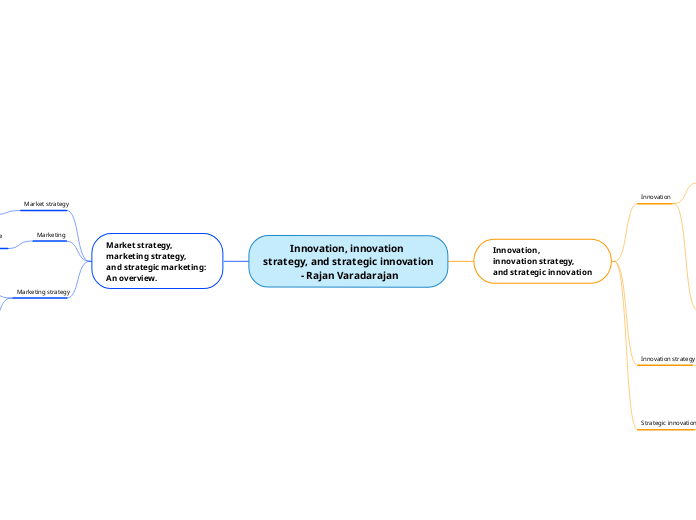Innovation, innovation
strategy, and strategic innovation
- Rajan Varadarajan
Innovation,
innovation strategy,
and strategic innovation
Innovation
The creation of value by using relevant knowledge and resources for the conversion of an idea into a new product, process, or practice or, improvements in an existing product, process, or practice.
Product innovation
Is the creation of value by using relevant knowledge and resources to implement an idea for a new product that meets a currently unmet need, a currently met need better than products presently available in the market, or a currently met need differently compared to products presently available in the market, or improvements in an existing product.
Business Model
Is the creation of value by using relevant knowledge and resources to implement an idea for a new business model that specifies the configuration of value chain activities, assets and costs, the revenue model, and the customer value proposition for competing in an industry, or improvements in one or more of the above elements of a currently employed business model in the industry.
Marketing innovation
Is the creation of value by using relevant knowledge and resources to implement an idea for a new method of marketing or, improvements in an existing method of marketing.
Advertising innovation, channel innovation, distribution innovation, packaging innovation, pricing innovation, and promoting innovation.
Notes: Innovation lately focuses on outsourcing offshore.
Innovations are also pervasive in a number of other areas such as policy innovations, organizational innovations, and administrative innovations. The word “practice” encompasses innovations in the above realms as well.
Innovation strategy
Is a firm’s relative emphasis on different types of innovations and the associated pattern of resource allocation, in alignment with its strategy at the corporate, business unit, and functional levels.
Corporate: Specifies a firm’s choice of businesses to be in, the mission assigned to individual businesses in the firm’s portfolio, and the allocation of resources among businesses in the firm’s portfolio.
Business: How a specific business in the firm’s portfolio will compete in the marketplace.
Organizational functions levels.
Strategic innovation
Is the creation of value by using relevant knowledge and resources to implement an idea for a new product, process, or practice with the potential to have a major transformational effect on the evolution of markets and industries.
Market strategy,
marketing strategy,
and strategic marketing:
An overview.
Market strategy
A firm’s decisions concerning markets to serve, mode of market entry, and order of market entry.
Marketing
The activity, set of institutions, and processes for creating, communicating, delivering, and exchanging offerings that have value for customers, clients, partners, and society.
Marketing strategy
Is an organization’s integrated pattern of decisions that specify its crucial choices concerning marketing activities to perform, the manner of performance of the activities in specific markets and market segments, and the allocation of marketing resources.
Notes: Marketing strategy is to influence customers’ effects, cognition, and behaviors. On the other hand, a firm’s knowledge of customers’ effects, cognitions, and behaviors influences its marketing strategy.
